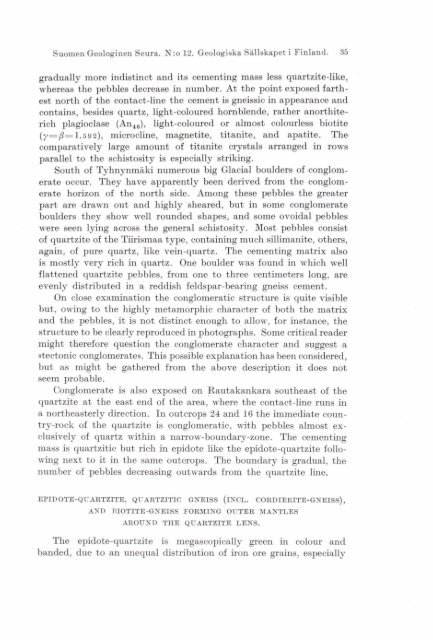GOHMISSION GEOLOGIQVE - Arkisto.gsf.fi
GOHMISSION GEOLOGIQVE - Arkisto.gsf.fi
GOHMISSION GEOLOGIQVE - Arkisto.gsf.fi
You also want an ePaper? Increase the reach of your titles
YUMPU automatically turns print PDFs into web optimized ePapers that Google loves.
Suomen Geologinen Seura. N:o 12. Geologiska Sallskapet i Finland. 35<br />
gradually more indistinct and its cementing mass less quartzite-like,<br />
whereas the pebbles decrease in number. At the point exposed farthest<br />
north of the contact-line the cement is gneissic in appearance and<br />
contains, besides quartz, light-coloured hornblende, rather anorthiterich<br />
plagioclase (An,,), light-coloured or almost colourless biotite<br />
(y=/?= 1.5~12)~ microcline, magnetite, titanite, and apatite. The<br />
comparatively large amount of titanite crystals arranged in rows<br />
parallel to the schistosity is especially striking.<br />
South of Tyhnynmäki numerous big Glacial boulders of conglomerate<br />
occur. They have apparently been derived from the conglomerate<br />
horizon of the north side. Among these pebbles the greater<br />
part are drawn out and highly sheared, but in some conglomerate<br />
boulders they show well rounded shapes, and some ovoidal pebbles<br />
were seen lying across the general schistosity. Most pebbles consist<br />
of quartzite of the Tiirismaa type, containing much sillimanite, others,<br />
again, of pure quartz, like vein-quartz. The cementing matrix also<br />
is mostly very rich in quartz. One boulder was found in which well<br />
flattened quartzite pebbles, from one to three centimeters long, are<br />
evenly distributed in a reddish feldspax-bearing gneiss cement.<br />
On close examination the conglomeratic structure is quite visible<br />
but, owing to the highly metamorphic character of both the matrix<br />
and the pebbles, it is not distinct enough to allow, for instance, the<br />
structure to be clearly reproduced in photographs. Some critical reader<br />
might therefore question the conglomerate character and suggest a<br />
*tectonic conglomerate>). This possible explanation has been considered,<br />
but as might be gathered from the above description it does not<br />
seem probable.<br />
Conglomerate is also exposed on Rautakankara southeast of the<br />
quartzite at the east end of the area, where the contact-he nuis in<br />
a northeasterly direction. In outcrops 24 and 16 the immediate country-rock<br />
of the quartzite is conglomeratic, with pebbles almost exclusively<br />
of quartz .within a narrow-boundary-zone. The cementing<br />
mass is quartzitic but rich in epidote like the epidote-quartzite following<br />
next to it in the same outcrops. The boundary is gradual, the<br />
number of pebbles decreasing outwards from the quartzite line.<br />
EPIDOTE-QUARTZITE, QUARTZiTIC ONEISS (INUL. CORDIERITE-ONEISS),<br />
AND BIOTITE-GNEISS FORMINO OUTER &UNTLES<br />
AROUND THE QUARTZITE LENS.<br />
The epidote-quarkzite is megascopically green in colour and<br />
banded, due to an unequal distribution of iron ore grains, especially
















